engine Citroen DS3 RHD 2015 1.G Owner's Guide
[x] Cancel search | Manufacturer: CITROEN, Model Year: 2015, Model line: DS3 RHD, Model: Citroen DS3 RHD 2015 1.GPages: 387, PDF Size: 12.26 MB
Page 65 of 387
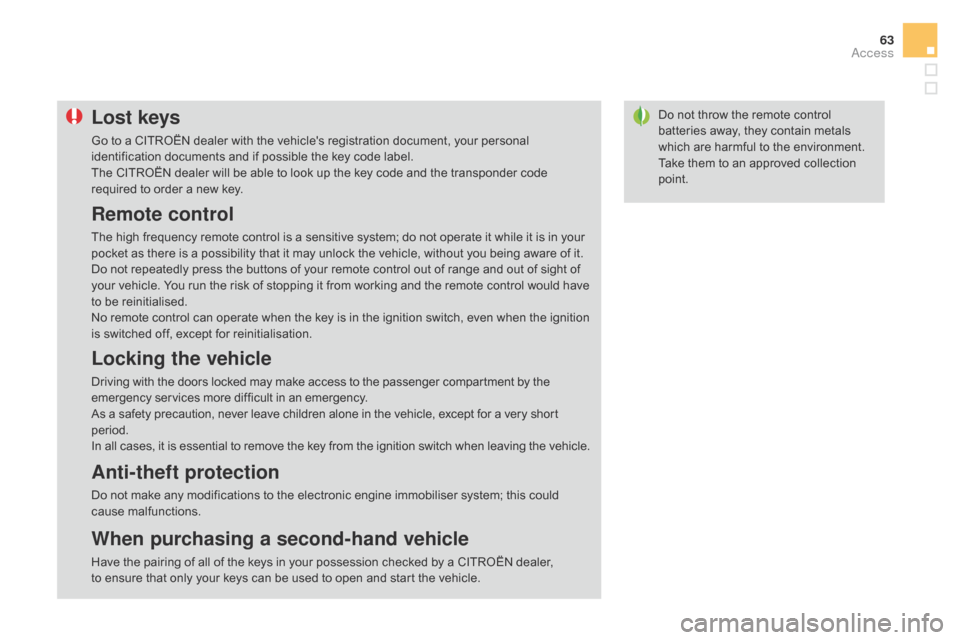
63
Do not throw the remote control batteries away, they contain metals
w
hich are harmful to the environment.
Take
them to an approved collection
po
int.Lost keys
Go to a CITROËN dealer with the vehicle's registration document, your personal identification documents and if possible the key code label.
The
CITROËN dealer will be able to look up the key code and the transponder code
r
equired to order a new key.
Remote control
The high frequency remote control is a sensitive system; do not operate it while it is in your pocket as there is a possibility that it may unlock the vehicle, without you being aware of it.
Do
not repeatedly press the buttons of your remote control out of range and out of sight of
y
our vehicle. You run the risk of stopping it from working and the remote control would have
t
o be reinitialised.
No
remote control can operate when the key is in the ignition switch, even when the ignition
i
s switched off, except for reinitialisation.
Locking the vehicle
Driving with the doors locked may make access to the passenger compartment by the emergency services more difficult in an emergency.
As
a safety precaution, never leave children alone in the vehicle, except for a very short
p
eriod.
In
all cases, it is essential to remove the key from the ignition switch when leaving the vehicle.
Anti-theft protection
Do not make any modifications to the electronic engine immobiliser system; this could cause m alfunctions.
When purchasing a second-hand vehicle
Have the pairing of all of the keys in your possession checked by a CITROËN dealer, to ensure that only your keys can be used to open and start the vehicle.
Access
Page 72 of 387
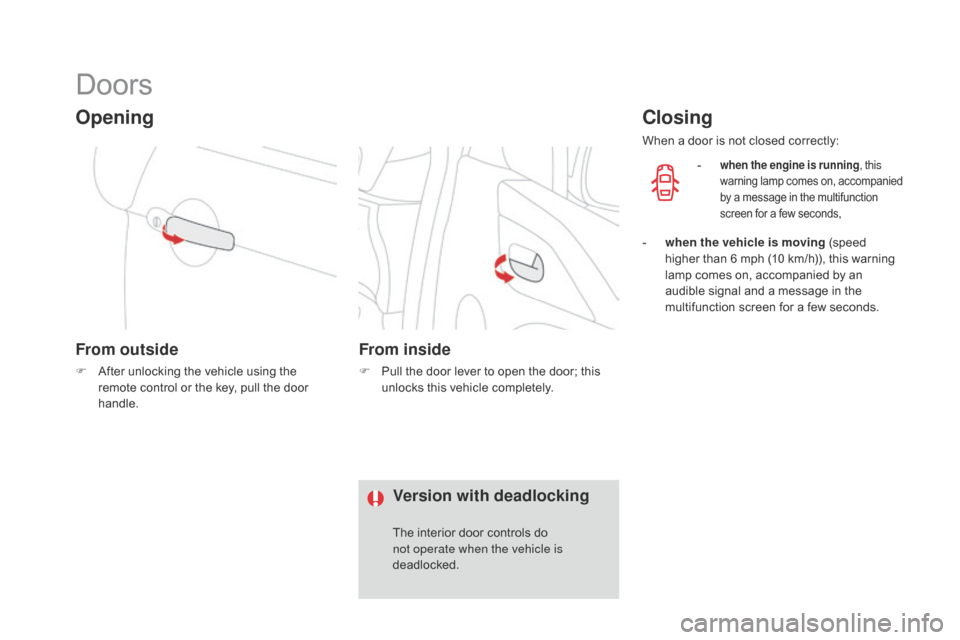
Doors
Opening
From outside
F After unlocking the vehicle using the r
emote control or the key, pull the door
han
dle.
From inside
F Pull the door lever to open the door; this u
nlocks this vehicle completely.
Closing
When a door is not closed correctly:
-
when the engine is running , this
warning lam p c omes o n, a ccompanied b
y a message in the multifunction
s
creen for a few seconds,
- when the vehicle is moving (speed h
igher than 6 mph (10 km/h)), this warning
l
amp comes on, accompanied by an
a
udible signal and a message in the
m
ultifunction screen for a few seconds.
Version with deadlocking
The interior door controls do not operate when the vehicle is
deadlocked.
Page 75 of 387

73
Boot
Opening
F After unlocking the vehicle, press the o
pening control and raise the tailgate.
Closing
F Lower the tailgate using the interior grab han
dle.
If
the tailgate is not closed correctly:
-
w
hen the engine is running ,
this
warning lamp comes on,
a
ccompanied by a message in
t
he multifunction screen for a few
se
conds,
-
w
hen the vehicle is moving (speed above
6
mph (10 km/h)), this warning lamp comes
o
n, accompanied by an audible signal and
a
message in the multifunction screen for a
f
ew seconds. System
for mechanical unlocking of the boot
i
n the event of a battery or central locking
m
alfunction.
Tailgate release
Unlocking
F Fold back the rear benchseat to gain a
ccess to the lock from inside the boot.
F
I
nsert a small screwdriver into hole A of the
lock
to unlock the tailgate.
Access
Page 88 of 387
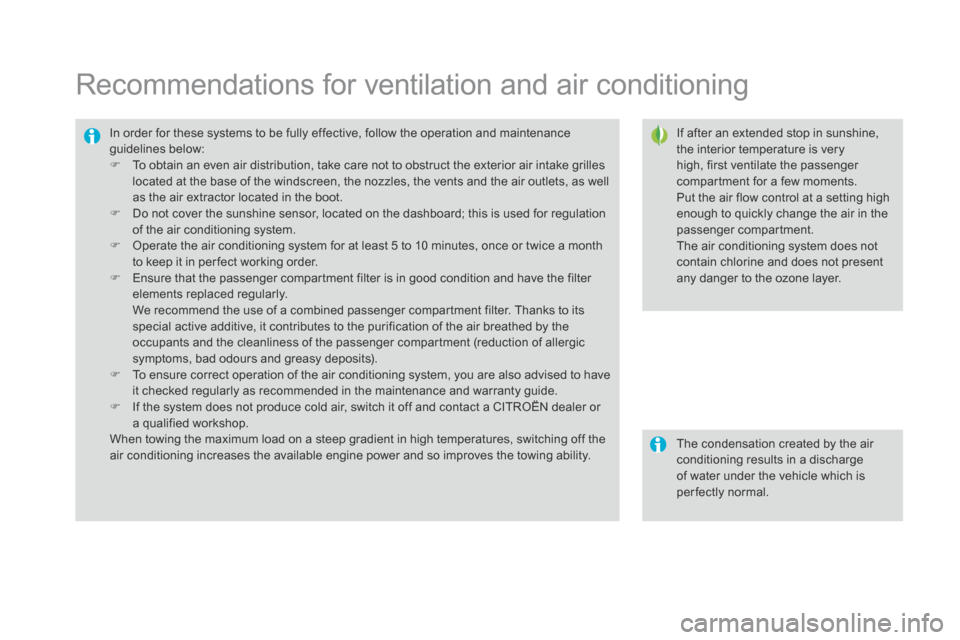
Recommendations for ventilation and air conditioning
If after an extended stop in sunshine, the interior temperature is very
h
igh, first ventilate the passenger
c
ompartment for a few moments.
Put
the air flow control at a setting high
e
nough to quickly change the air in the
p
assenger
c
ompartment.
The
air conditioning system does not
c
ontain chlorine and does not present
a
ny danger to the ozone layer.
In
order
for
these
systems
to
be
fully
effective,
follow
the
operation
and
maintenance
g
uidelines belo
w:
F
T
o
obtain
an
even
air
distribution,
take
care
not
to
obstruct
the
exterior
air
intake
grilles
l
ocated
at
the
base
of
the
windscreen,
the
nozzles,
the
vents
and
the
air
outlets,
as
well
a
s
the
air
extractor
located
in
the
boot.
F
D
o
not
cover
the
sunshine
sensor,
located
on
the
dashboard;
this
is
used
for
regulation
o
f
the
air
conditioning
system.
F
O
perate
the
air
conditioning
system
for
at
least
5
to
10
minutes,
once
or
twice
a
month
t
o
keep
it
in
per fect
working
order.
F
E
nsure
that
the
passenger
compartment
filter
is
in
good
condition
and
have
the
filter
e
lements
replaced
regularly.
W
e
recommend
the
use
of
a
combined
passenger
compartment
filter.
Thanks
to
its
s
pecial
active
additive,
it
contributes
to
the
purification
of
the
air
breathed
by
the
o
ccupants
and
the
cleanliness
of
the
passenger
compartment
(reduction
of
allergic
s
ymptoms,
bad
odours
and
greasy
deposits).
F
T
o
ensure
correct
operation
of
the
air
conditioning
system,
you
are
also
advised
to
have
i
t
checked
regularly
as
recommended
in
the
maintenance
and
warranty
guide.
F
I
f
the
system
does
not
produce
cold
air,
switch
it
off
and
contact
a
CITROËN
dealer
or
a
qualified
workshop.
When
towing
the
maximum
load
on
a
steep
gradient
in
high
temperatures,
switching
off
the
a
ir
conditioning
increases
the
available
engine
power
and
so
improves
the
towing
ability. The
condensation created by the air
c
onditioning results in a discharge
o
f water under the vehicle which is
p
er fectly normal.
Page 90 of 387

The heating / ventilation or air conditioning systems operates with the engine running, as well as in STOP mode with Stop & Start.
1. Temperature adjustment
F Turn the dial from blue (
cold) to red (hot) to adjust
t
he temperature to your
r
equirements.
2. Air flow adjustment
F Turn the dial from position 1
to position 5 to obtain a
comfortable
air flow.
F
I
f you place the air flow control
in position 0
(deactivation of the
s
ystem), the temperature is no
l
onger maintained at a comfortable
l
evel. However, a slight flow of air,
d
ue
t
o
t
he
m
ovement
o
f
t
he
v
ehicle,
c
an still be felt.
3. Air distribution adjustment
Windscreen and side windows.
W indscreen, side windows and
f
ootwells.
Footwells.
Central
and side vents.
The
air distribution can be
a
dapted by placing the dial
i
n an intermediate position.
4. Air intake / Air recirculation
The intake of exterior air avoids the formation of mist on the windscreen and side windows.
The recirculation of interior air insulates the
passenger
compartment from exterior odours
a
nd smoke.
Return
to exterior air intake as soon as possible
t
o prevent deterioration of the air quality and
t
he formation of mist.
Manual control panel F
M
ove the manual control to
t
he left to be in the "recycling
i
nterior air" position.
F
M
ove the manual control to the
r
ight to return to the "fresh air
i
ntake" position.
Page 92 of 387
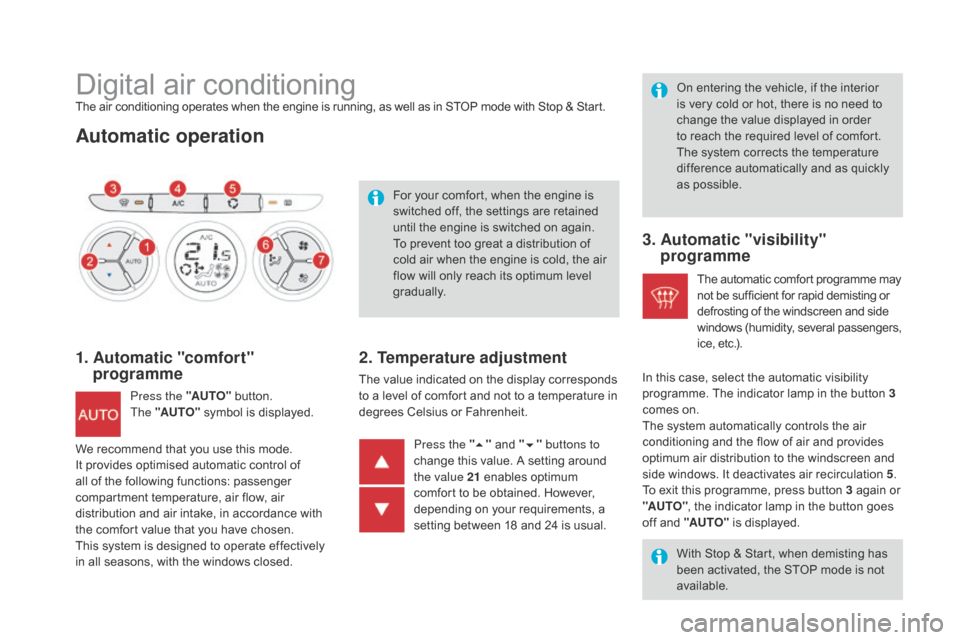
Digital air conditioningThe air conditioning operates when the engine is running, as well as in STOP mode with Stop & Start.
Automatic operation
1. Automatic "comfort" programme
Press the "AUTO" button. T
he "AUTO" symbol is displayed. For
your comfort, when the engine is
s
witched off, the settings are retained
u
ntil the engine is switched on again.
To prevent too great a distribution of
c
old air when the engine is cold, the air
f
low will only reach its optimum level
g
radually.
2. Temperature adjustment
The value indicated on the display corresponds t
o a level of comfort and not to a temperature in
d
egrees Celsius or Fahrenheit. On
entering the vehicle, if the interior
i
s very cold or hot, there is no need to
c
hange the value displayed in order
t
o reach the required level of comfort.
T
he system corrects the temperature
d
ifference automatically and as quickly
a
s possible.
Press the " 5"
and "6 " buttons to
change
this value. A setting around
t
he value 21
enables optimum
c
omfort to be obtained. However,
d
epending on your requirements, a
s
etting between 18 and 24 is usual.
3. Automatic "visibility" programme
The automatic comfort programme may n
ot be sufficient for rapid demisting or d
efrosting of the windscreen and side
w
indows
(
humidity,
se
veral
p
assengers,
i
ce, etc.).
With
Stop & Start, when demisting has
b
een activated, the STOP mode is not
a
vailable.
In
this
case, select the automatic visibility
p
rogramme. The indicator lamp in the button 3
comes
on.
The
system automatically controls the air
c
onditioning and the flow of air and provides
o
ptimum
air distribution to the windscreen and
s
ide
windows. It deactivates air recirculation 5.
To
exit
this programme, press button 3 again or
"A
UTO" ,
the indicator lamp in the button goes
o
ff
and
"AUTO"
is displayed.
We
recommend
that
you
use
this
mode.
I
t
provides
optimised
automatic
control
of
a
ll
of
the
following
functions:
passenger
c
ompartment
temperature,
air
flow,
air
d
istribution
and
air
intake,
in
accordance
with
t
he
comfort
value
that
you
have
chosen.
This
system
is
designed
to
operate
effectively
i
n
all
seasons,
with
the
windows
closed.
Page 96 of 387

Rear screen demist - defrost
The control button is located on the heating or air conditioning system control panel.
Switching on
The rear screen demisting/defrosting can only operate when the engine is running.
F
P
ress this button to demist /defrost the
r
ear screen and (depending on version)
t
he door mirrors. The indicator lamp
a
ssociated with the button comes on.
Switching off
The demisting/defrosting switches off automatically to prevent an excessive
c
onsumption of current.
F
I
t is possible to stop the demisting/
defrosting
operation before it is switched
o
ff automatically by pressing the button
a
gain. The indicator lamp associated with
t
he button switches off. Switch
off the demisting/defrosting
o
f the rear screen and door mirrors
a
s soon as appropriate, as reducing e
lectrical power consumption results in r
educed f uel c onsumption.
If the engine is switched off before the d
emisting/defrosting is switched off a
utomatically,
d
emisting/defrosting
w
ill
r
esume next time the engine is switched on.
Scented air
f
reshener
This diffuses a fragrance in the passenger c
ompartment, by means of the adjustment dial
a
nd the various fragrance cartridges available.
This
dial is located on the dashboard.
It
allows you to adjust the intensity of diffusion
o
f the fragrance.
F
T
urn the dial to the right to permit diffusion
o
f the fragrance.
F
T
urn the dial to the left to stop diffusion of
t
he
f
ragrance.
Adjustment dial
Leave the central vents open.
T he intensity of diffusion of the
f
ragrance may depend on the
v
entilation or air conditioning settings.
Page 106 of 387
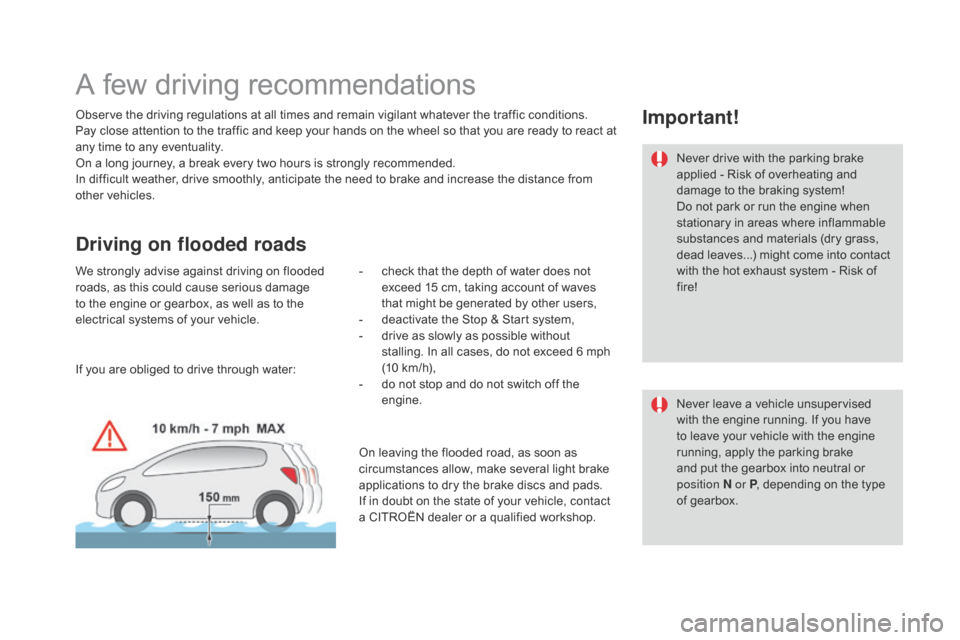
A few driving recommendations
Observe the driving regulations at all times and remain vigilant whatever the traffic conditions.
P ay close attention to the traffic and keep your hands on the wheel so that you are ready to react at
a
ny time to any eventuality.
On
a long journey, a break every two hours is strongly recommended.
In
difficult weather, drive smoothly, anticipate the need to brake and increase the distance from
o
ther
v
ehicles.
driving on flooded roads
We strongly advise against driving on flooded roads, as this could cause serious damage
t
o the engine or gearbox, as well as to the
e
lectrical systems of your vehicle.
Important!
Never drive with the parking brake applied - Risk of overheating and
d
amage to the braking system!
Do
not park or run the engine when
s
tationary in areas where inflammable
s
ubstances and materials (dry grass,
d
ead leaves...) might come into contact
w
ith the hot exhaust system - Risk of
f
ire!
Never
leave a vehicle unsupervised
w
ith the engine running. If you have
t
o leave your vehicle with the engine
r
unning, apply the parking brake
a
nd put the gearbox into neutral or
p
osition
n or P,
depending on the type
o
f gearbox.
-
c
heck
that
the
depth
of
water
does
not
e
xceed
15
cm,
taking
account
of
waves
t
hat
might
be
generated
by
other
users,
-
d
eactivate
the
Stop
&
Start
system,
-
d
rive
as
slowly
as
possible
without
s
talling.
In
all
cases,
do
not
exceed
6
mph
(
10 km/h),
-
d
o
not
stop
and
do
not
switch
off
the
e
ngine.
If
you
are
obliged
to
drive
through
water: On
leaving
the
flooded
road,
as
soon
as
c
ircumstances
allow,
make
several
light
brake
a
pplications
to
dry
the
brake
discs
and
pads.
If
in
doubt
on
the
state
of
your
vehicle,
contact
a
CITROËN
dealer
or
a
qualified
workshop.
Page 107 of 387

105
Anti-theft protection
Electronic engine immobiliser
The key contains an electronic chip which has a special code. When the ignition is switched
o
n, this code must be recognised in order for
s
tarting to be possible.
This
electronic engine immobiliser locks the
e
ngine management system a few moments
a
fter the ignition is switched off and prevents
s
tarting of the engine by anyone who does not
h
ave the key.In the event of a fault, you are
informed
by illumination of this
w
arning lamp, an audible signal and
a
message in the screen.It
has 3 positions:
-
P
osition 1: Stop
-
P
osition 2: Ignition on
-
P
osition 3: Starting
Ignition switch
Ignition on
In this position the vehicle's electrical equipment can be used or accessories
c
harged.
When
the state of charge of the battery
d
rops to a reserve level, the system goes into
e
nergy economy mode: the power supply is
a
utomatically cut off to preserve the state of
c
harge of the battery.
Keep
safely,
away
from
your
vehicle,
t
he
label
attached
to
the
keys
given
to
y
ou
on
acquisition
of
the
vehicle.
Starting-switching off the engine
In this case, your vehicle will not start; contact a CITROËN dealer as soon as possible.
Avoid
attaching heavy objects to the
k
ey, which would weigh down on its
b
lade in the ignition switch and could
c
ause a malfunction.
driving
Page 108 of 387

F Apply the parking brake.
F W ith a manual gearbox: place the lever in
n
eutral and fully depress the clutch pedal.
F
W
ith an electronic gearbox: place the lever
a
t position n and press the brake pedal
f
i r m l y.
F
W
ith an automatic gearbox: place the lever
a
t position P and press the brake pedal
f
i r m l y.
F
I
nsert the key in the ignition switch; the
s
ystem recognises the code.
F
U
nlock the steering column by
s
imultaneously turning the steering and the
k
ey.
Starting the engine
In some circumstances, you may have to apply some force to turn the steering
w
heel (wheels on lock for example).In
wintry conditions, the warning lamp
w
ill stay on longer. When the engine is
h
ot, it does not come on.In temperate conditions, do not
w
arm the engine up with the vehicle
s
tationary, but move off straight away
a
nd drive at moderate engine speeds.
If the engine does not start straight a
way, switch the ignition off. Wait a
f
ew moments before trying again. If
t
he engine does not start after a few
a
ttempts, do not keep trying: you risk
d
amaging the starter motor and the
e
ngine. Call on a CITROËN dealer or a
q
ualified
w
orkshop.Never
leave the engine running in
a
n enclosed area without adequate
v
entilation:
in
ternal
c
ombustion
e
ngines emit toxic exhaust gases,
s
uch as carbon monoxide. Danger of
i
ntoxication and death. In very severe
w
inter conditions (temperatures b
elow -23°C), it is necessary to allow t
he engine to run for 4 minutes before
s
etting off, in order to ensure the
c
orrect operation and durability of
t
he mechanical components of your
v
ehicle, the engine and gearbox.
F
W
ith a petrol engine, operate the starter
m
otor by turning the key to position 3 until
the
engine starts, without pressing the
a
ccelerator pedal. Once the engine starts,
r
elease the key.
F
W
ith a Diesel engine, turn the key to
p
osition 2 ,
ignition on, to operate the
eng
ine
p
reheating
s
ystem. Wait
until this warning lamp goes off
i
n the instrument panel, then operate
t
he starter motor by turning the key to
p
osition
3
until the engine starts, without
p
ressing the accelerator pedal. Once
t
he engine starts, release the key.